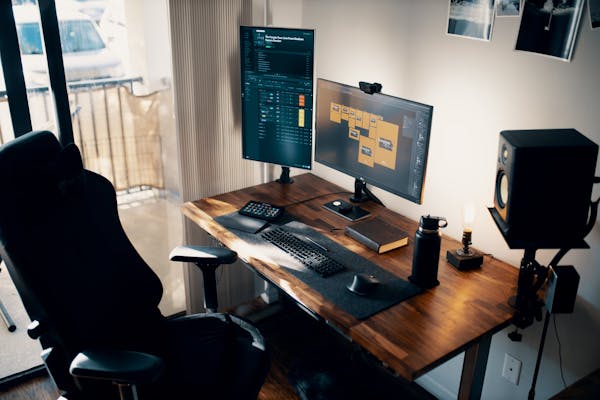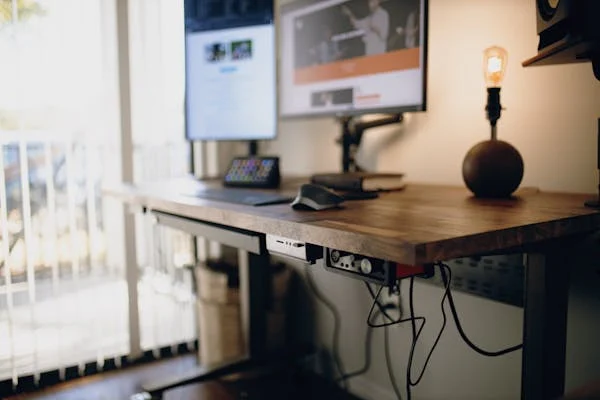7 Powerful Tips for Choosing Ergonomic Office Equipment for Remote Work
Remote work is here to stay, and with it comes an increasing need for a comfortable and productive home office. The key to achieving a workspace that supports both your health and productivity lies in selecting the right ergonomic office equipment for remote work. This specialized equipment is designed to reduce physical strain, enhance posture, and minimize discomfort, ultimately boosting your overall work performance. Whether you’re working full-time remotely or in a hybrid setup, investing in high-quality ergonomic office equipment for remote work is crucial to creating a sustainable and efficient environment.
Ergonomic office equipment for remote work includes a range of tools such as chairs, desks, keyboards, mice, and other accessories that promote healthy body mechanics during long hours of work. For example, an ergonomic chair supports proper lumbar alignment and encourages good posture, while an adjustable desk allows you to alternate between sitting and standing, helping to prevent back pain and improve circulation. Accessories like ergonomic keyboards and vertical mice are designed to reduce the risk of repetitive strain injuries, such as carpal tunnel syndrome. Furthermore, monitor stands and laptop docking stations ensure your screen is positioned at eye level, reducing neck strain and eye fatigue.
In this guide, we’ll walk you through the essentials of choosing the best ergonomic office equipment for remote work, ensuring that you not only enhance your productivity but also safeguard your health. Whether you’re just setting up your home office or looking to optimize your current workspace, the right ergonomic office equipment for remote work will make a lasting difference in your comfort and well-being.
Why Ergonomics Matter for Remote Work
When working from home, it’s easy to overlook the importance of ergonomic office equipment for remote work. Unlike traditional office setups with specialized furniture, remote workspaces often rely on makeshift arrangements. Unfortunately, neglecting ergonomics can result in long-term physical issues such as back pain, carpal tunnel syndrome, and eye strain.
What is Ergonomic Office Equipment?
Why You Should Care About Ergonomics in Your Remote Workspace
- Posture Improvement: The right ergonomic office equipment for remote work is designed to keep your body aligned and promote proper posture throughout the workday. By using an ergonomic chair with lumbar support and adjusting your desk height, you can reduce the likelihood of poor posture and the associated pain, such as back, neck, and shoulder discomfort. This improvement in posture helps prevent strain and encourages healthier body mechanics, making a noticeable difference in your daily comfort levels.
- Increased Comfort: With the right ergonomic office equipment for remote work, you’ll experience less discomfort and fatigue, even during long working hours. Items like ergonomic keyboards and mice can significantly reduce wrist strain, while adjustable sit-stand desks allow you to shift between sitting and standing, promoting better circulation. These tools help you stay comfortable, focused, and productive for longer periods, minimizing distractions caused by discomfort.
- Long-Term Health Benefits: Investing in ergonomic office equipment for remote work today can have long-term health benefits by preventing chronic pain and injuries that can develop over time. Poor posture and repetitive strain can lead to issues such as carpal tunnel syndrome, neck pain, and lumbar discomfort. By using ergonomic products, you reduce the risks of these health problems, saving you from expensive medical treatments down the line and ensuring a healthier and more productive work environment for years to come.
Key Ergonomic Office Equipment for Remote Work
Now that we understand the importance of ergonomics, let’s dive into the ergonomic office equipment for remote work that every remote worker should consider. This section covers everything from chairs to desks, ensuring you have the tools to build a comfortable and productive workspace.
1. Ergonomic Chairs: The Backbone of Your Setup

What to Look for in an Ergonomic Chair
- Lumbar Support: A good chair provides support for your lower back, helping to reduce pressure on the spine.
- Seat Depth: The seat should allow you to sit with your back against the chair while keeping your feet flat on the floor.
- Adjustability: A chair that can be adjusted for height, armrests, and back tilt is key to finding the most comfortable position for your body.
Top Ergonomic Chair Recommendations
- Herman Miller Aeron: A high-quality chair with customizable settings for a perfect fit.
- Steelcase Leap: Known for its support and adjustability, this chair is a great option for remote workers.
2. Adjustable Desks: Sit, Stand, and Stay Comfortable
While an ergonomic chair is essential, incorporating ergonomic office equipment for remote work, such as a sit-stand desk, takes your comfort to the next level. Adjustable desks allow you to alternate between sitting and standing, helping to reduce back pain and boost energy levels throughout the day. This key piece of ergonomic office furniture not only enhances posture but also promotes better circulation, contributing to improved productivity and overall comfort during long remote work hours.
Why Sit-Stand Desks are Important
- Improved Posture: Alternating between sitting and standing encourages better posture and reduces strain.
- Increased Energy: Standing for parts of the day helps prevent the fatigue that can come from sitting for long periods.
Recommended Adjustable Desks for Remote Work
- Uplift V2 Standing Desk: A reliable sit-stand desk with smooth transitions between sitting and standing positions.
- Fully Jarvis Desk: Known for its stability and height adjustability, making it perfect for remote workers.
3. Ergonomic Keyboards and Mice: A Crucial Investment
Typing on a keyboard that is not part of ergonomic office equipment for remote work can lead to wrist strain and discomfort. Investing in an ergonomic keyboard and mouse setup helps prevent long-term injuries, such as carpal tunnel syndrome, by promoting a natural wrist position. These ergonomic tools are essential for maintaining comfort and productivity during long work hours in your home office setup. By choosing the right ergonomic office equipment, you can reduce strain and improve overall workplace ergonomics.
Key Features to Look for in Ergonomic Keyboards and Mice
- Keyboard Tilt: Look for keyboards that allow you to adjust the angle, reducing wrist strain.
- Split Keyboards: A split design encourages a more natural hand position.
- Vertical Mice: These mice reduce wrist rotation, helping to prevent strain.
Top Ergonomic Keyboards and Mice
- Microsoft Sculpt Ergonomic Keyboard: A great option with a split keyboard design that promotes a natural typing position.
- Logitech MX Vertical Mouse: A vertical mouse that encourages a more neutral wrist position, reducing strain.
4. Computer Monitors and Adjustable Stands
Having a monitor at eye level is essential for maintaining good posture and preventing strain, especially for remote workers. Many remote workers use laptops with poor positioning, leading to neck strain and discomfort. An adjustable monitor stand is a simple but effective solution that can help bring your screen to eye level, promoting better posture and reducing neck strain. By incorporating this ergonomic office equipment into your remote work setup, you can enhance comfort and productivity throughout your workday.
Why Monitor Position Matters
- Eye Comfort: When your monitor is at the right height, it reduces the strain on your eyes, preventing fatigue and headaches.
- Neck Health: Proper positioning ensures you’re not craning your neck, reducing the risk of neck pain.
Best Monitors and Stands for Ergonomic Workspaces
- Dell UltraSharp 27-inch Monitor: A large, adjustable monitor that offers excellent clarity and eye-friendly features.
- VIVO Adjustable Monitor Stand: A cost-effective way to raise your monitor to an optimal viewing height.
Ergonomic Accessories to Enhance Comfort
In addition to the major pieces of ergonomic office equipment for remote work, there are several ergonomic accessories that can help make your workspace even more comfortable. These ergonomic accessories support your posture, reduce strain on your body, and enhance your overall ergonomic setup. By integrating items like footrests, wrist rests, and lumbar support cushions, you can further improve your home office ergonomics to ensure maximum comfort and productivity throughout your workday.

Footrests and Anti-Fatigue Mats
Wrist and Lumbar Support Products
How to Customize Your Ergonomic Setup
Everyone’s body is unique, which is why customizing your ergonomic setup for remote work is crucial. Proper adjustments ensure that each piece of ergonomic office equipment works for you, enhancing comfort, reducing strain, and promoting better posture. Here’s how you can customize your ergonomic office equipment for remote work to meet your individual needs:
Choosing the right ergonomic office equipment for remote work is a smart investment that not only enhances your physical health but also significantly boosts your productivity. By selecting the appropriate ergonomic office chair, an adjustable sit-stand desk, a comfortable ergonomic keyboard, and essential ergonomic accessories, you can create a workspace that promotes good posture, reduces discomfort, and supports long hours of productive work.
A well-designed ergonomic workspace helps to prevent strain, minimizes fatigue, and encourages natural movement, which is crucial for maintaining focus and comfort throughout the workday. By implementing the tips outlined in this guide, you’ll optimize your remote work setup, leading to improved posture, reduced back and wrist pain, and increased energy levels. Creating a healthy home office not only makes remote work more enjoyable but also maximizes your efficiency and long-term well-being.
For more tips on creating a comfortable and productive workspace, check out our guide on Ergonomic Home Office Design Ideas.
FAQ
1. What is the most important piece of ergonomic office equipment?
The most important piece is an ergonomic chair. It supports proper posture and prevents back pain during long hours of sitting.
2. How can I prevent wrist strain while working from home?
Investing in an ergonomic keyboard and mouse can help maintain a natural wrist position, reducing strain.
3. Do I really need an adjustable desk?
While not essential for everyone, a sit-stand desk can significantly reduce back pain and improve comfort by allowing you to alternate between sitting and standing.
4. What should I do if my home office space is small?
You can still create an ergonomic setup in a small space by using compact, adjustable furniture and focusing on proper alignment.
5. How can I ensure my monitor is at the correct height?
The top of your monitor should be at or just below eye level to reduce neck strain.
6. Is it worth investing in ergonomic accessories like wrist rests?
Yes, wrist rests and lumbar support cushions can make a big difference in comfort, especially for long workdays.
7. How often should I take breaks when working remotely?
Aim to take a short break every 30-60 minutes to stretch and move around, especially if you’re sitting for extended periods.
8. Can ergonomic equipment really improve productivity?
Yes, reducing discomfort and pain through ergonomic equipment can help you stay focused and productive for longer periods.


